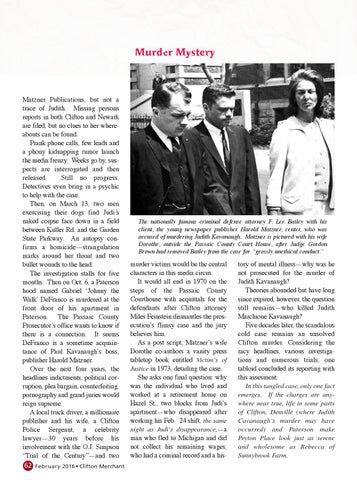Matzner Publications, but not a trace of Judith. Missing persons reports in both Clifton and Newark are filed, but no clues to her whereabouts can be found. Prank phone calls, few leads and a phony kidnapping rumor launch the media frenzy. Weeks go by, suspects are interrogated and then released. Still no progress. Detectives even bring in a psychic to help with the case. Then, on March 13, two men exercising their dogs find Judi’s naked corpse face down in a field between Kuller Rd. and the Garden State Parkway. An autopsy confirms a homicide—strangulation marks around her throat and two bullet wounds to the head. The investigation stalls for five months. Then on Oct. 6, a Paterson hood named Gabriel ‘Johnny the Walk’ DeFranco is murdered at the front door of his apartment in Paterson. The Passaic County Prosecutor’s office wants to know if there is a connection. It seems DeFranco is a sometime acquaintance of Paul Kavanaugh’s boss, publisher Harold Matzner. Over the next four years, the headlines indictments, political corruption, plea bargain, counterfeiting, pornography and grand juries would reign supreme. A local truck driver, a millionaire publisher and his wife, a Clifton Police Sergeant, a celebrity lawyer—30 years before his involvement with the O.J. Simpson “Trial of the Century”—and two 62 February 2016 • Clifton Merchant
The nationally famous criminal defense attorney F. Lee Bailey with his client, the young newspaper publisher Harold Matzner, center, who was accused of murdering Judith Kavanaugh. Matzner is pictured with his wife Dorothe, outside the Passaic County Court House, after Judge Gordon Brown had removed Bailey from the case for “grossly unethical conduct.”
murder victims would be the central characters in this media circus. It would all end in 1970 on the steps of the Passaic County Courthouse with acquittals for the defendants after Clifton attorney Miles Feinstein dismantles the prosecution’s flimsy case and the jury believes him. As a post script, Matzner’s wife Dorothe co-authors a vanity press tabletop book entitled Victim’s of Justice in 1973, detailing the case. She asks one final question: why was the individual who lived and worked at a retirement home on Hazel St., two blocks from Judi’s apartment—who disappeared after working his Feb. 24 shift, the same night as Judi’s disappearance,—a man who fled to Michigan and did not collect his remaining wages, who had a criminal record and a his-
tory of mental illness—why was he not prosecuted for the murder of Judith Kavanaugh? Theories abounded but have long since expired, however, the question still remains—who killed Judith Marchione Kavanaugh? Five decades later, the scandalous cold case remains an unsolved Clifton murder. Considering the racy headlines, various investigations and numerous trials, one tabloid concluded its reporting with this assesment: In this tangled case, only one fact emerges. If the charges are anywhere near true, life in some parts of Clifton, Denville (where Judith Cavanaugh’s murder may have occurred) and Paterson make Peyton Place look just as serene and wholesome as Rebecca of Sunnybrook Farm.
